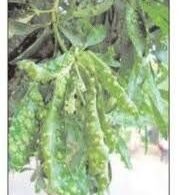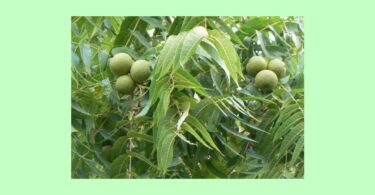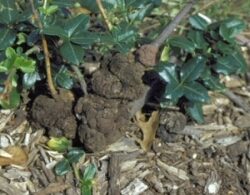Radko Tichavsky is a Czech born Mexican Agrohomeopath. He is a co-founder and director of Instituto Comenius in Mexico and author of Handbook of Agrohomeopathy, 2007 (Spanish) and Homeopathy for Plants, 2009 (Spanish), Organon de la Holohomeopatía and creator and teacher of Holohomeopathy.
He is now offering a one semester virtual course in Holohomeopathy (in English). You can learn how to define and analyze holons and how to repertorize the specific homeopathic treatment beyond just disease or pest names. You can find out more here: www.icomenius.edu.mx
NEW BOOK:
Organon de la Holohomeopatía
Six years in the making, it is the latest book by Radko Tichavsky, researcher on the application of homeopathy in agriculture. This Spanish language book covers homeopathic interventions in agriculture from the holistic view, allowing greater certainty in repertorizations. It addresses a novel concept of metabolic similarity, not only among plants, but also among different species of the animal and plant kingdom. It studies the formation and dynamics of attractors, areas of greater vitality within the holons and coexistence units of different living organisms Holohomeopathy is a fascinating contribution to the application of homeopathy to plants. It allows one to discover a universe of surprising relations in vital dynamism. It puts into the hands of the agricultural producer, a valuable tool for the successful handling of pests and diseases in crops of any size. For ordering or information: [email protected]
Dear Mr. Tichavsky,
We tried growing a crop of potatoes for the first time last summer. They grew well but then developed Potato Scab (Streptomyces scabies ). While they were still edible, we couldn’t sell them at market. Is there something we can do this year to prevent that problem? Our land is in Tom’s River New Jersey (U.S. ) ZIP CODE 08755. The climate is moderate with growing season temperatures ranging from 54 Fahrenheit to 86 F. We get 48 inches of rain a year.
Thank you
Susan Byrne
Radko Tichavsky:
Hi Susan,
To avoid Potato scab (Streptomyces scabies) you have to take into account that when it is persistent it is often a consequence of lack of crop alternation. You can alternate for example with narrow leafed lupin (Lupinus angustifolius), white mustard (Sinapis alba), buckwheat (Fagopyrum esculentum) in proportion of 70-20-10 kg of seed per hectare. Once this alternative crop grows it must be cut down and left on the surface so that a biodiverse microbios will be established in your soil.
As for the holo-homeopathic applications, we use live bionosode of Aloe vera radix at a potency of 2 JT and applications of dynamized oregano´s essential oil at a 3 JT potency.
Cut a piece of Aloe vera root, wash it well with a brush under water, then clean it with alcohol at 30% with a brush and clean it again under water. Put the root in a blender with mineral water (tasteless only with CO2 bubbled water) and a little of well-cooked rice and blend the mixture for 1 minute.
Leave the mixture in the air at a temperature above 20 degrees Celsius for 24 hours and then filter the contents (e.g. through a coffee filter or fine cloth). To prepare 200 l of the 2 JT potency you will use 20 ml of this mixture and incorporate it into 1980 ml of water. Then you make 500 vigorous succussions in a glass bottle, and then incorporate it into 198 liters of water and make 500 continuous turns to the right and 500 continuous turns to the left with a wooden stick. In this way you will get live bionosode of Aloe vera radix which must be sprayed on the soil before the potato sowing.
In this way you introduce dynamized strains of Bacillus subtilis, Bacillus amylolicuefasciens and Bacillus megaterium that form the community of bacteria, antagonistic to Streptomyces scabies. Oregano essential oil applications at 3 JT potency should be made once a month.
Dear Dr. Tichavsky,
Is there a natural toxic way to prevent damage to carrot crops by the Root Maggot. We lost many carrot plants for the last two years. We refuse to use toxic chemical on our fields. We live in Knoxville Tennessee (Zip 37920 ) Rainfall is 58 in./year. Summer high temperatures go up to 88 degrees (F).
Thank you
Anthony Esposito
Radko Tichavsky:
Dear Anthony,
The Psilia rosae that causes the condition called “root maggot” requires several steps. First of all, not sowing the carrot in the same place, except after three years, decreases the possibility of the attack. Although several biological control methods have been suggested, such as application of nematodes using Staphylinidae, Carabidae insects and also some spiders, the fact that larvae remain on the soil but are oviposited by a fly discourages good results.
The second step is to apply Cuprum metallicum 6 CH on the seeds before sowing. The third step is to avoid sowing carrot monocultures and use intercropping with onions or garlic (one row of carrots one of garlic, one of carrots, one of onions and so on). Liliaceae plants generally help to control this pest effectively.
On the crop you can apply alternated Colchicum autumnale 12 CH, and Aloe vera 6 CH with a little sunflower oil (Helianthus annuus as an adjuvant. In your area you can also look for the wilde plant Toxicoscordion nuttallii to elaborate mother tincture of its roots and to realize the dynamization to the 12 CH potency. Apply alternatively once a week with the other two mentioned remedies. This remedy should not be applied two weeks before the collection of the roots.
Dear Radko,
My pear tree appears to be unwell. A friend who is a gardener thinks it has red spider mite, and also some leaves are going black and falling. We’ve repotted it to but we’re trying to find how we can help the health of the leaves. It has some sun in the morning and shaded light later afternoon. It’s a container kept tree, from dwarfing stock (bought from an organic nursery 18 months ago).

Thank you
Em Colley – Homeopath – [email protected]
Radko Tichavsky:
Dear Em,
The tree in the picture seems to have several pathogenic conditions not only one (mite, possibly Eriohyes pyri, and also possibly Fusicladium sp.) This is the frequent condition where the opportunistic fungus takes advantage of the wound caused by E. pyri to parasitize the plant.
To control the red spider mite, Sulphur 6 CH can be applied in autumn together with oil of Heliathus annuus as an adjuvant, but when the tree is already in its productive stage (as in the image) the applications of Sulphur are not recommended. In this case you can prepare mother tincture of the Boswelia sacra resin. That is the scientific name of the plant whose resin is used as incense in churches.
Crush the incense to a fine powder, place it in 30% alcohol and leave it to extract for a week. Then prepare the second centesimal dynamization. For example, if you are going to occupy 20 liters of the preparation at the potency 2 CH, you can start the dynamization from 2 ml of TM placed in 198 ml of water, and then make 100 vigorous succussions in a glass bottle.
Then pour this potency 1 CH into 198 l of water and make 100 turns with a wooden stick on the right and 100 turns on the left. To the 20 liters of the 2 CH potency add 20 ml of Helianthus annuus oil as an adjuvant and spray onto your trees in the afternoon. Usually one application is enough, but if necessary, you can repeat the application in a week.
Dear Professor Radko Tichavsky,
I have a white-flowered Camellia, Apple Blossom, which is emitting new vegetations with many black spots on the tips of the leaves and then the leaf rots. I have already given Taraxacum.
Thank you
Roberto Migliorelli
Radko Tichavsky:
Dear Roberto,
Camellia japonica is a crop quite resistant to fungi, so when it gets sick from fungi it is usually difficult to manage. Thuja occidentalis 6 Ch can be helpful and also a homeopathic preparation of the essential oil of Melaleuca alternifolia 6 CH (although it is popularly known as “tea tree” and belongs to another family: Myrthaceae). You should temporarily reduce watering and add some river sand to the substrate to help improve water drainage in the pot.
Dear Dr. Tichavsky,
I am sending you a photo of my indoor plant Pachira aquatica. I put it in a 10 inch pot as it seemed to be doing so well and was outgrowing the 6 inch one.
It has been many months now. It is growing taller but keeps losing leaves
The leaves look healthy but suddenly turn brown and drop off. I add 2.5 cups of water almost every week when the soil is dry. If I put more in, the tips of leaves start to turn yellow. I give the plant rescue remedy and 5 drops of 12 tissue salts every week. I don’t see any insects.
Thank you
Perviz
Radko Tichavsky:
Dear Perviz,
The Pachira acuatica is a plant with high requirements of light. When it lacks light, its leaves become yellowish and elongated. Try opening the blind in the window for one hour early in the morning and the rest of the day cover it, as it is in the photo, with the blind closed.
As far as watering is concerned, the plant’s soil must always be moist (not waterlogged). Decrease the amount of irrigation water by dividing it into two parts applied with shorter periods. Also add to one litre of water 10 drops of Magnesia carbonica 6 CH and with this remedy spray the leaves of the plant (also on the underside of the leaves) once every two or three days. It is better to place the plant in a clay pot that allows better breathing of the roots and proper drainage.










I’ve been referred to your educational site by my Homeopath – very interesting. Potato scab is a problem in “sweet” soils. Reducing the PH seems to work well… or alternatively, don’t apply sweeteners like agricultural lime to the soil.
Dear Dr. I have a problem with White Rot fungus in my garlic. I’m practicing long crop rotations, but it is difficult in my small garden. Farmers in England discovered that spraying onion waste residue on the ground late summer the year prior to planting offers great control. Apparently the fungus senses Allium “food”, wakes up to go feast, but finding nothing but smell, starves to death.
I’m wondering if I can make a remedy from my diseased plants to apply to next year’s plot? Or has someone already created such a remedy? Is so, I think it might be beneficial to apply it to future beds… perhaps two or three consecutive years to add extra protection?
Thank you for your consideration.
Dear Garth, thanks for your interest in agro-homeopathy, the methods you describe are based on isopathy, which can have a positive impact but on principle after the application of isopathy (bionosode made from the same plant or the plant of the same family) nature always leaves 10% of the disease living which in practical terms will mean the permanence of the fungus in chronic form.
You can control this fungus definitivelly by preparing live bionosode from the root of Aloe vera, which contains rhizobacteria (bacteria which adhere to the roots of the plants, occupy the space and antagonize the fungus permanently. Even if you re-sow your own garlic then one application will be enough to make all subsequent generations free of the fungus.
You should get little of fresh Aloe vera roots, wash them well in tap water with a brush, then rinse with 30% alcohol (for example some vodka) and then rinse well in the water again. Then put some of the root in the blender with water and blend for 1 minute. On the other hand, cook two potatoes well, let them cool down and remove the peel and add them together with the juice I prepare from the Aloe vera roots and blend everything again for 1 minute. The liquid is left out in the open for 4 days and once a foam appears on the surface it is diluted in a ratio of 1:100 in water and with a wooden stick it will make 500 turns to the right and 500 turns to the left forming a vortex. Then he sprinkles it on the ground where his garlic is. In this way he will inoculate his plants and the soil with Bacullus subtilis, Bacillus amyloliquefasciens and Bacillus megaterium bacteria that will occupy the space in the roots and in the soil. Try not to move the soil so as not to destroy the colony of the bacteria so they will protect your garlic without having to alternate different crops and they will do it perfectly. Greetings Radko Tichavsky